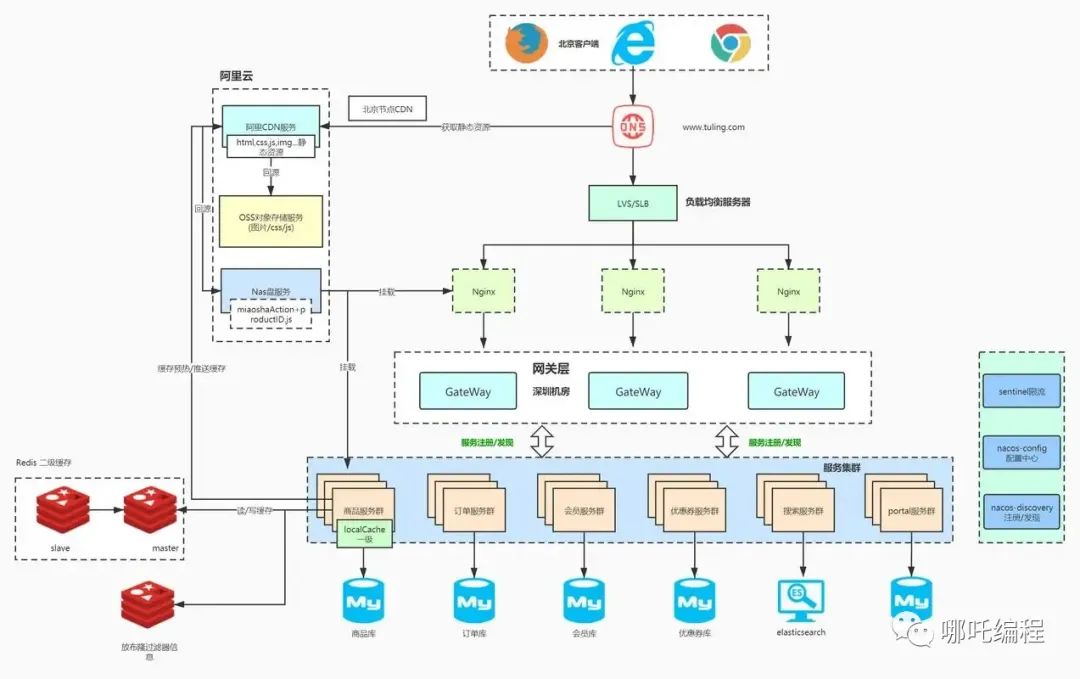SpringBoot 调用外部接口的四种方式
1、简介
在Spring-Boot项目开发中,当本模块的代码需要访问外面模块接口,或外部url链接的需求的时候, 需要使用网络连接调用,下面提供了四种方式(排除dubbo的方式)供大家选择。
方式一:使用OKHttp
网上对于 OkHttp 相关的介绍如下!
OkHttp 是 Square 公司基于 JAVA 和 Android 程序,封装的一个高性能 http 网络请求客户端,并且对外开源,它的设计初衷是为了更快地加载资源并节省带宽。
使用 OkHttp 的主要优势:
- 支持HTTP/2(有效使用套接字)
- 连接池(在没有HTTP/2的情况下减少请求延迟)
- GZIP压缩(缩小下载大小)
- 响应缓存(避免了重新获取相同的数据)
- 从常见的连接问题中无声恢复
- 替代 IP 地址检测(在 IPv4 和 IPv6 环境下)
- 支持现代TLS功能(TLS 1.3,ALPN,证书钉子)
- 支持同步和异步调用
目前 OkHttp 在开源项目中被广泛使用,同时也是 Retrofit、Picasso 等库的核心库。springboot已经很好地支持okhttp库。

2.1、添加依赖包
在使用之前,我们需要先导入okhttp依赖包,不同的版本号,相关 api 稍有区别,本次介绍的 api 操作基于3.14.9版本号。
<dependency>
<groupId>com.squareup.okhttp3</groupId>
<artifactId>okhttp</artifactId>
<version>3.14.9</version>
</dependency>
2.2、get 同步请求
okhttp发起get同步请求非常的简单,只需要几行代码就可以搞定。
案例如下!
String url = "https://www.bAIdu.com/";
OkHttpClient client = new OkHttpClient();
// 配置GET请求
Request request = new Request.Builder()
.url(url)
.get()
.build();
// 发起同步请求
try (Response response = client.newCall(request).execute()){
// 打印返回结果
System.out.println(response.body().string());
} catch (Exception e) {
e.printStackTrace();
}
2.3、post 表单同步请求
okhttp发起post表单格式的数据提交,同步请求编程也非常的简单,只需要几行代码就可以搞定。
案例如下!
String url = "https://www.baidu.com/";
OkHttpClient client = new OkHttpClient();
// 配置 POST + FORM 格式数据请求
RequestBody body = new FormBody.Builder()
.add("userName", "zhangsan")
.add("userPwd", "123456")
.build();
Request request = new Request.Builder()
.url(url)
.post(body)
.build();
// 发起同步请求
try (Response response = client.newCall(request).execute()){
// 打印返回结果
System.out.println(response.body().string());
} catch (Exception e) {
e.printStackTrace();
}
2.4、post 表单 + 文件上传,同步请求
如果在发起表单请求的时候,还需要上传文件,该如何实现呢?
案例如下!
String url = "https://www.baidu.com/";
OkHttpClient client = new OkHttpClient();
// 要上传的文件
File file = new File("/doc/Downloads/429545913565844e9b26f97dbb57a1c3.jpeg");
RequestBody fileBody = RequestBody.create(MediaType.parse("image/jpg"), file);
// 表单 + 文件数据提交
RequestBody multipartBody = new MultipartBody.Builder()
.setType(MultipartBody.FORM)
.addFormDataPart("userName", "zhangsan")
.addFormDataPart("userPwd", "123456")
.addFormDataPart("userFile", "00.png", fileBody)
.build();
Request request = new Request.Builder()
.url(url)
.post(multipartBody)
.build();
// 发起同步请求
try (Response response = client.newCall(request).execute()){
// 打印返回结果
System.out.println(response.body().string());
} catch (Exception e) {
e.printStackTrace();
}
2.5、post + json 数据,同步请求
okhttp发起post + json格式的数据提交,同步请求编程也很简单。
案例如下!
MediaType contentType = MediaType.get("Application/json; charset=utf-8");
String url = "https://www.baidu.com/";
String json = "{}";
OkHttpClient client = new OkHttpClient();
// 配置 POST + JSON 请求
RequestBody body = RequestBody.create(contentType, json);
Request request = new Request.Builder()
.url(url)
.post(body)
.build();
// 发起同步请求
try (Response response = client.newCall(request).execute()){
// 打印返回结果
System.out.println(response.body().string());
} catch (Exception e) {
e.printStackTrace();
}
2.5、文件下载,同步请求
文件下载,通常是get方式请求,只需要在响应端使用字节流接受数据即可!
案例如下
public static void main(String[] args) {
//目标存储文件
String targetFile = "/doc/Downloads/1.png";
//需要下载的原始文件
String url = "https://www.baidu.com/img/PCtm_d9c8750bed0b3c7d089fa7d55720d6cf.png";
OkHttpClient client = new OkHttpClient();
// 配置GET请求
Request request = new Request.Builder()
.url(url)
.build();
// 发起同步请求
try (Response response = client.newCall(request).execute()){
// 获取文件字节流
byte[] stream = response.body().bytes();
// 写入目标文件
writeFile(targetFile, stream);
} catch (Exception e) {
e.printStackTrace();
}
}
/**
* 写入目标文件
* @param targetFile
* @param stream
* @throws IOException
*/
private static void writeFile(String targetFile, byte[] stream) throws IOException {
String filePath = StringUtils.substringBeforeLast(targetFile, "/");
Path folderPath = Paths.get(filePath);
if(!Files.exists(folderPath)){
Files.createDirectories(folderPath);
}
Path targetFilePath = Paths.get(targetFile);
if(!Files.exists(targetFilePath)){
Files.write(targetFilePath, stream, StandardOpenOption.CREATE);
}
}
2.6、其他方式的同步请求
在实际的项目开发中,有的接口需要使用put或者delete方式请求,应该如何处理呢?
put方式请求,案例如下!
// 只需要在 Request 配置类中,换成 put 方式即可
Request request = new Request.Builder()
.url(url)
.put(body)
.build();
同样的,delete方式请求也类似,案例如下!
// 只需要在 Request 配置中,换成 delete 方式即可
Request request = new Request.Builder()
.url(url)
.delete(body)
.build();
2.7、自定义添加请求头部
大部分的时候,基于安全的考虑,很多时候我们需要把相关的鉴权参数放在请求头部,应该如何处理呢?
以post + json格式请求为例,添加头部请求参数,案例如下!
MediaType contentType = MediaType.get("application/json; charset=utf-8");
String url = "https://www.baidu.com/";
String json = "{}";
OkHttpClient client = new OkHttpClient();
// 配置 header 头部请求参数
Headers headers = new Headers.Builder()
.add("token", "11111-22222-333")
.build();
// 配置 POST + JSON 请求
RequestBody body = RequestBody.create(contentType, json);
Request request = new Request.Builder()
.url(url)
.headers(headers)
.post(body)
.build();
// 发起同步请求
try (Response response = client.newCall(request).execute()){
// 打印返回结果
System.out.println(response.body().string());
} catch (Exception e) {
e.printStackTrace();
}
2.8、发起异步请求
在上文中我们介绍的都是同步请求,在最开始我们也说到 OkHttp 不仅支持同步调用,也异步调用,那么如何进行异步请求编程呢?
其实操作很简单,案例如下!
String url = "https://www.baidu.com/";
OkHttpClient client = new OkHttpClient().newBuilder().build();
Request request = new Request.Builder()
.url(url)
.get()
.build();
// 发起异步请求
client.newCall(request).enqueue(new Callback() {
@Override
public void onFailure(Call call, IOException e) {
System.out.println("请求异常 + " + e.getMessage());
}
@Override
public void onResponse(Call call, Response response) throws IOException {
System.out.println("请求完成,返回结果:" + response.body().string());
}
});
方式二:使用原始httpClient请求
使用Apache httpclient库。
/* * @description get方式获取入参,插入数据并发起流程
* @author ly
* @params documentId
* @return String
*/
//
@RequestMapping("/submit/{documentId}")
public String submit1(@PathVariable String documentId) throws ParseException {
//此处将要发送的数据转换为json格式字符串
Map<String,Object> map =task2Service.getMap(documentId);
String jsonStr = JSON.toJSONString(map, SerializerFeature.WRITE_MAP_NULL_FEATURES,SerializerFeature.QuoteFieldNames);
JSONObject jsonObject = JSON.parseobject(jsonStr);
JSONObject sr = task2Service.doPost(jsonObject);
return sr.toString();
}
/*
* @description 使用原生httpClient调用外部接口
* @author ly
* @params date
* @return JSONObject
*/
public static JSONObject doPost(JSONObject date) {
String assessToken="eyJ0eXAiOiJKV1QiLCJhbGciOiJIUzUxMiJ9.eyJ4ZGFwYXBwaWQiOiIzNDgxMjU4ODk2OTI2OTY1NzYiLCJleHAiOjE2NjEyMjY5MDgsImlhdCI6MTY2MTIxOTcwOCwieGRhcHRlbmFudGlkIjoiMzAwOTgxNjA1MTE0MDUyNjA5IiwieGRhcHVzZXJpZCI6IjEwMDM0NzY2MzU4MzM1OTc5NTIwMCJ9.fZAO4kJSv2rSH0RBiL1zghdko8Npmu_9ufo6Wex_TI2q9gsiLp7XaW7U9Cu7uewEOaX4DTdpbFmMPvLUtcj_sQ";
CloseableHttpClient client = HttpClients.createDefault();
// 要调用的接口url
String url = "http://39.103.201.110:30661 /xdap-open/open/process/v1/submit";
HttpPost post = new HttpPost(url);
JSONObject jsonObject = null;
try {
//创建请求体并添加数据
StringEntity s = new StringEntity(date.toString());
//此处相当于在header里头添加content-type等参数
s.setContentType("application/json");
s.setContentEncoding("UTF-8");
post.setEntity(s);
//此处相当于在Authorization里头添加Bear token参数信息
post.addHeader("Authorization", "Bearer " +assessToken);
HttpResponse res = client.execute(post);
String response1 = EntityUtils.toString(res.getEntity());
if (res.getStatusLine()
.getStatusCode() == HttpStatus.SC_OK) {
// 返回json格式:
String result = EntityUtils.toString(res.getEntity());
jsonObject = JSONObject.parseObject(result);
}
} catch (Exception e) {
throw new RuntimeException(e);
}
return jsonObject;
}
、方式三:使用RestTemplate方法
Spring-Boot开发中,RestTemplate同样提供了对外访问的接口API,这里主要介绍Get和Post方法的使用。
Get请求
提供了getForObject 、getForEntity两种方式,其中getForEntity如下三种方法的实现:
Get--getForEntity,存在以下两种方式重载
1.getForEntity(Stringurl,Class responseType,Object…urlVariables)
2.getForEntity(URI url,Class responseType)
Get--getForEntity(URI url,Class responseType)
//该方法使用URI对象来替代之前的url和urlVariables参数来指定访问地址和参数绑定。URI是JDK java.NET包下的一个类,表示一个统一资源标识符(Uniform Resource Identifier)引用。参考如下:
RestTemplate restTemplate=new RestTemplate();
UriComponents
uriComponents=UriComponentsBuilder.fromUriString("http://USER-SERVICE/user?name={name}")
.build()
.expand("dodo")
.encode();
URI uri=uriComponents.toUri();
ResponseEntityresponseEntity=restTemplate.getForEntity(uri,String.class).getBody();
Get--getForObject,存在以下三种方式重载
1.getForObject(String url,Class responseType,Object...urlVariables)
2.getForObject(String url,Class responseType,Map urlVariables)
3.getForObject(URI url,Class responseType)
getForObject方法可以理解为对getForEntity的进一步封装,它通过HttpMessageConverterExtractor对HTTP的请求响应体body内容进行对象转换,实现请求直接返回包装好的对象内容。
Post 请求
Post请求提供有postForEntity、postForObject和postForLocation三种方式,其中每种方式都有三种方法,下面介绍postForEntity的使用方法。
Post--postForEntity,存在以下三种方式重载
1.postForEntity(String url,Object request,Class responseType,Object... uriVariables)
2.postForEntity(String url,Object request,Class responseType,Map uriVariables)
3.postForEntity(URI url,Object request,Class responseType)
如下仅演示第二种重载方式
/*
* @description post方式获取入参,插入数据并发起流程
* @author ly
* @params
* @return
*/
@PostMapping("/submit2")
public Object insertFinanceCompensation(@RequestBody JSONObject jsonObject) {
String documentId=jsonObject.get("documentId").toString();
return task2Service.submit(documentId);
}
/*
* @description 使用restTimeplate调外部接口
* @author ly
* @params documentId
* @return String
*/
public String submit(String documentId){
String assessToken="eyJ0eXAiOiJKV1QiLCJhbGciOiJIUzUxMiJ9.eyJ4ZGFwYXBwaWQiOiIzNDgxMjU4ODk2OTI2OTY1NzYiLCJleHAiOjE2NjEyMjY5MDgsImlhdCI6MTY2MTIxOTcwOCwieGRhcHRlbmFudGlkIjoiMzAwOTgxNjA1MTE0MDUyNjA5IiwieGRhcHVzZXJpZCI6IjEwMDM0NzY2MzU4MzM1OTc5NTIwMCJ9.fZAO4kJSv2rSH0RBiL1zghdko8Npmu_9ufo6Wex_TI2q9gsiLp7XaW7U9Cu7uewEOaX4DTdpbFmMPvLUtcj_sQ";
RestTemplate restTemplate = new RestTemplate();
//创建请求头
HttpHeaders httpHeaders = new HttpHeaders();
//此处相当于在Authorization里头添加Bear token参数信息
httpHeaders.add(HttpHeaders.AUTHORIZATION, "Bearer " + assessToken);
//此处相当于在header里头添加content-type等参数
httpHeaders.add(HttpHeaders.CONTENT_TYPE,"application/json");
Map<String, Object> map = getMap(documentId);
String jsonStr = JSON.toJSONString(map);
//创建请求体并添加数据
HttpEntity<Map> httpEntity = new HttpEntity<Map>(map, httpHeaders);
String url = "http://39.103.201.110:30661/xdap-open/open/process/v1/submit";
ResponseEntity<String> forEntity = restTemplate.postForEntity(url,httpEntity,String.class);//此处三个参数分别是请求地址、请求体以及返回参数类型
return forEntity.toString();
}
、方式四:使用Feign进行消费
在maven项目中添加依赖
<dependency>
<groupId>org.springframework.cloud</groupId>
<artifactId>spring-cloud-starter-feign</artifactId>
<version>1.2.2.RELEASE</version>
</dependency>
启动类上加上@EnableFeignClients
@SpringBootApplication
@EnableFeignClients
@ComponentScan(basePackages = {"com.definesys.mpaas", "com.xdap.*" ,"com.xdap.*"})
public class MobilecardApplication {
public static void main(String[] args) {
SpringApplication.run(MobilecardApplication.class, args);
}
}
此处编写接口模拟外部接口供feign调用外部接口方式使用
定义controller
@Autowired
PrintService printService;
@PostMapping("/outSide")
public String test(@RequestBody TestDto testDto) {
return printService.print(testDto);
}
定义service
@Service
public interface PrintService {
public String print(TestDto testDto);
}
定义serviceImpl
public class PrintServiceImpl implements PrintService {
@Override
public String print(TestDto testDto) {
return "模拟外部系统的接口功能"+testDto.getId();
}
}
构建Feigin的Service
定义service
//此处name需要设置不为空,url需要在.properties中设置
@Service
@FeignClient(url = "${outSide.url}", name = "service2")
public interface FeignService2 {
@RequestMapping(value = "/custom/outSide", method = RequestMethod.POST)
@ResponseBody
public String getMessage(@Valid @RequestBody TestDto testDto);
}
定义controller
@Autowired
FeignService2 feignService2;
//测试feign调用外部接口入口
@PostMapping("/test2")
public String test2(@RequestBody TestDto testDto) {
return feignService2.getMessage(testDto);
}
postman测试

此处因为我使用了所在项目,所以需要添加一定的请求头等信息,关于Feign的请求头添加也会在后续补充
补充如下:
添加Header解决方法
将token等信息放入Feign请求头中,主要通过重写RequestInterceptor的apply方法实现
定义config
@Configuration
public class FeignConfig implements RequestInterceptor {
@Override
public void apply(RequestTemplate requestTemplate) {
//添加token
requestTemplate.header("token", "eyJ0eXAiOiJKV1QiLCJhbGciOiJIUzUxMiJ9.eyJ4ZGFwYXBwaWQiOiIzNDgxMjU4ODk2OTI2OTY1NzYiLCJleHAiOjE2NjEyMjY5MDgsImlhdCI6MTY2MTIxOTcwOCwieGRhcHRlbmFudGlkIjoiMzAwOTgxNjA1MTE0MDUyNjA5IiwieGRhcHVzZXJpZCI6IjEwMDM0NzY2MzU4MzM1OTc5NTIwMCJ9.fZAO4kJSv2rSH0RBiL1zghdko8Npmu_9ufo6Wex_TI2q9gsiLp7XaW7U9Cu7uewEOaX4DTdpbFmMPvLUtcj_sQ");
}
}
定义service
@Service
@FeignClient(url = "${outSide.url}",name = "feignServer", configuration = FeignDemoConfig.class)
public interface TokenDemoClient {
@RequestMapping(value = "/custom/outSideAddToken", method = RequestMethod.POST)
@ResponseBody
public String getMessage(@Valid @RequestBody TestDto testDto);
}
定义controller
//测试feign调用外部接口入口,加上token
@PostMapping("/testToken")
public String test4(@RequestBody TestDto testDto) {
return tokenDemoClient.getMessage(testDto);
}


























